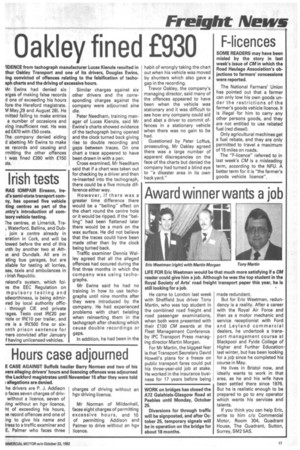Oakley fined £930
Page 7

If you've noticed an error in this article please click here to report it so we can fix it.
FIDENCE from tachograph manufacturer Lucas Kienzle resulted in thur Oakley Transport and one of its drivers, Douglas Ewins, ing convicted of offences relating to the falsification of tachomph charts and the driving of excessive hours.
Tr Ewins had denied six arges of making false records d one of exceeding his hours fore the Hereford magistrate. W May.,29 and August 28). He milted failing to make entries a number of occasions and ving insufficient rest. He was ad £470 with £50 costs.
rhe company denied aiding d abetting Mr Ewins to make se records and causing and rmitting the other offences t was fined £390 with £150 its. Similar charges against six other drivers and the corresponding charges against the company were adjourned sine die.
Peter Needham, training manager of Lucas Kienzle, said Mr Ewins's charts showed evidence of the tachograph being opened and the clock turned back giving rise to double recording and gaps between traces. On one chart a trace appeared to have been drawn in with a pen.
Cross examined, Mr Needham said that if a chart was taken out for checking by a driver and then re-inserted into the tachograph, there could be a five minute difference either way.
However, if there was a greater time difference there would be a "belling" effect on the chart round the centre hole or it would be ripped. If the "belling" had been flattened later there would be a mark on the wax surface. He did not believe that the traces could have been made other than by the clock being turned back.
Traffic examiner Dennis Walley agreed that all the alleged offences had occured during the first three months in which the company was using tachographs.
Mr Ewins said he had no training in how to use tachographs until nine months after they were introduced by the company. He had experienced problems with chart twisting when reinserting them in the tachograph after checking which cause double recordings or gaps.
In addition, he had been in the habit of wrongly taking the chart out when his vehicle was moved by shunters which also gave a gap in the recording.
Trevor Oakley, the company's managing director, said many of the offences appeared to have been when the vehicle was stationary and it was difficult to see how any company could aid and abet a driver to commit offences in a stationary vehicle when there was no gain to be had.
Questioned by Peter Loftus, prosecuting, Mr Oakley agreed there was a large number of apparent discrepancies on the face of the charts but denied the company had turned a blind eye to "a disaster area in its own back yard."


















































































































